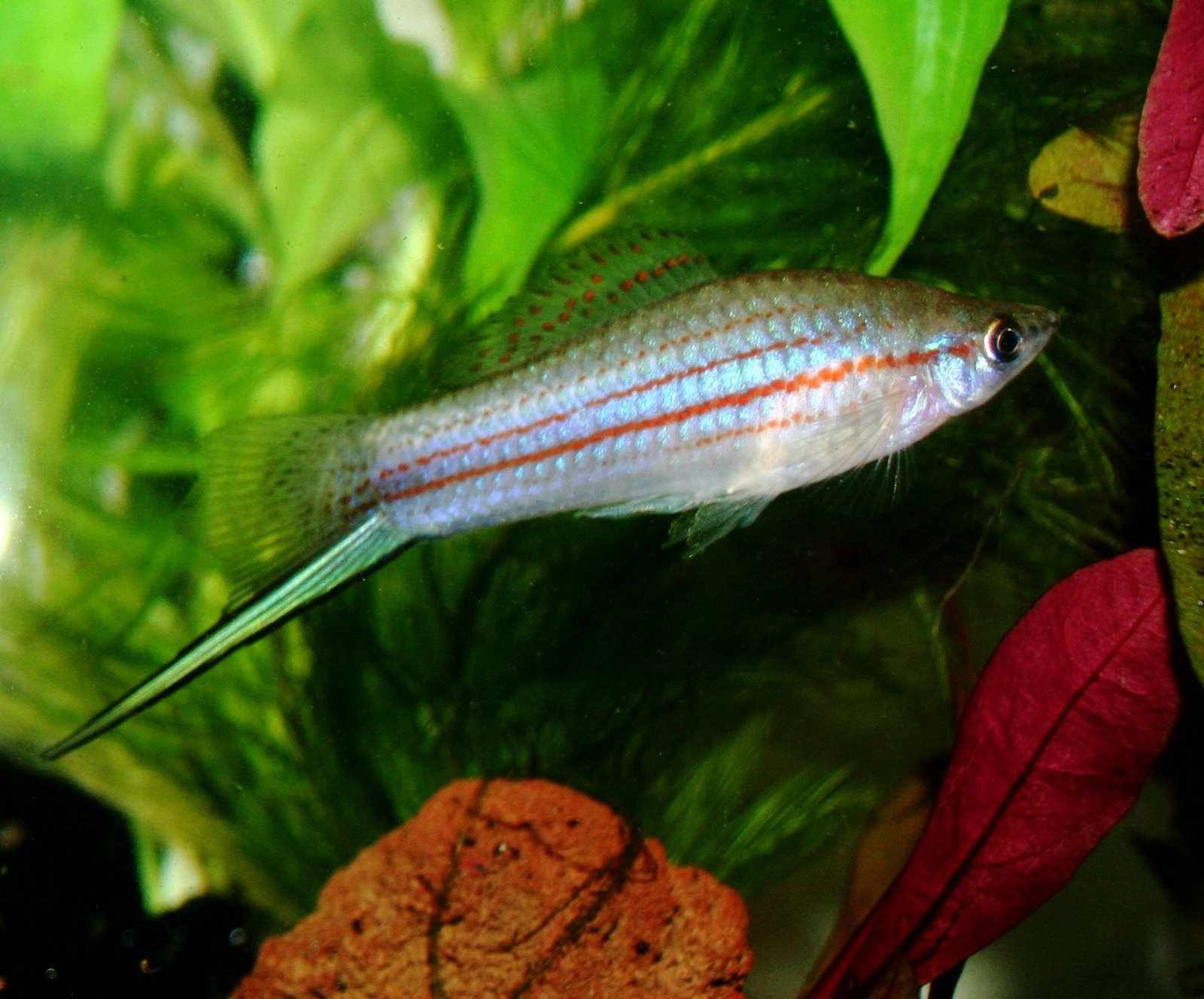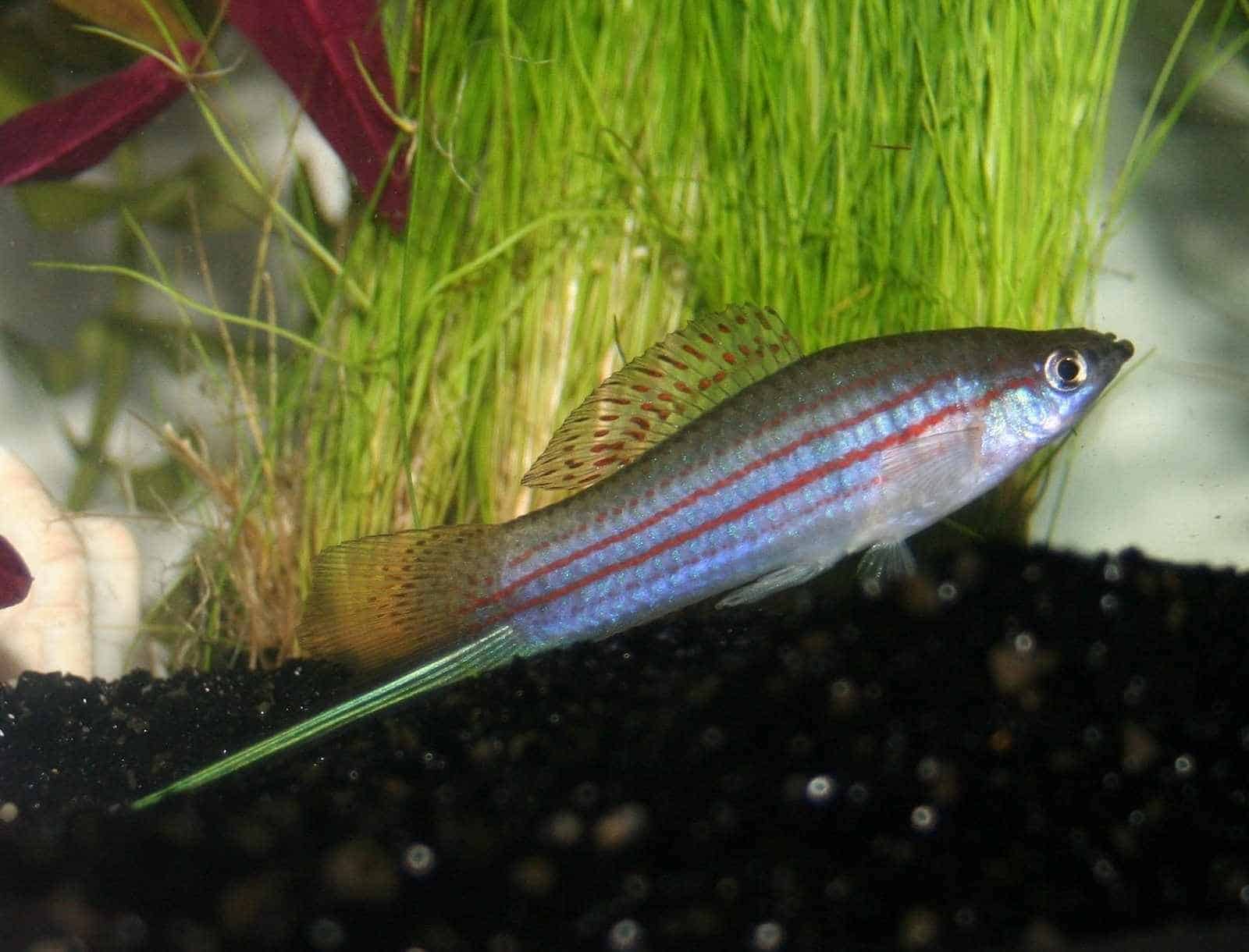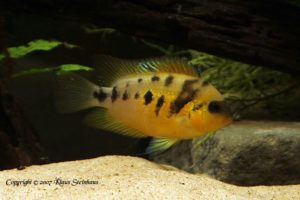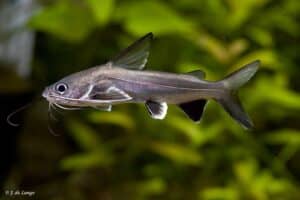Xiphophorus mayae
The name xiphophorus means swordbearer in Dutch, the name mayae comes from an ancient Indian tribe. Hence the name Xiphophorus mayae. With some fish species, after years of research, people give it a different name. This also happened with Xiphophorus mayae formerly Xiphophorus helleri sp. ‘PMH’.
It was soon known that this helleri species was different from most other Xiphophorus species. Rosen himself thought so in 1979 when he first described this little fish,which is why he called it Xiphophorus sp’ PMH. It was researched and later named by Meyer & Schartl and given its own name in 2002. With us he has also been known under the name five stripe helleri, and many still call him that. Count the rows of stripes vertically from bottom to top, there are five, hence the name. In the common Xiphophorus helleri there are usually only 3.
Origin
Xiphophorus mayae is native to the Rio Polochic, Rio Matagua basin and its country of origin is Honduras (Guatemala). This Xiphophorus species falls under the large or southern swordtails. This further includes the following swordtails:
- The green Xiphophorus helleri
- the comma swordtails Xiphophorus signum
- The yellow swordtail Xiphophorus clemencia
- And the Alvarez swordtail Xiphophorus alvarezi.
Since the Xiphophorus helleri has a very large range of over 1000 km, in the course of evolution it has adopted many different types and forms. All helleri species are also closely related to each other, except from the Catemaco, this one appears to be more different from the others. The Alvarez swordtail (Xiphophorus alvarezi) seems to be most closely related to the Xiphophorus mayae.
Size
The Xiphorus mayae is one of the largest among the Xiphophorus species and can grow up to 9.5 cm. Of course this is a wild specimen, with me they usually do not get much bigger than 8 cm. Fortunately, last year I was able to obtain larger animals through Mr. Macalester from England.
The young from this pair are immediately much larger than from my other strain. They also grow much faster than my other fish, so you see that you have to watch out with inbreeding. That they grow faster or smaller in an aquarium depends of course on the circumstances in which you have the fish swimming. Think of the size of your aquarium, the food supply and the temperature in your aquarium.
Description
The Xiphophorus mayae has four or five horizontal lines and was often called among the members of Poecilia Nederland (viviparous association) five stripe helleri. It is a very tolerant swordtail, which should certainly be kept in somewhat larger aquariums (120 cm and larger).
In the past I had them swimming in an 80 cm aquarium,but this really turned out to be much too small. Now they swim in a 120 cm tank and they are doing much better. This swordtail was very popular in the past, but because of too many newer species we lost them. Fortunately, Cor van de Sande and Jaap Jan de Greef later caught them again in Rio de la Pasion in Guatemala.
These two gentlemen brought them back to the Netherlands fortunately Artis had also included them in a special breeding program otherwise we would have lost them again in our country. I got these Xiphophorus mayae from Ludo Couvreur who I am very grateful to this day. Kees de Jong has been in the U.S.A. this past year and there too they have become very scarce. More than 30 euros per pair was laid down at a viviparous symposium there.

Fortunately this is different in the Netherlands and most people can get them for less including myself.
This species I breed together with a friend of mine Johan Ezeman and if it goes wrong with him or me we can fall back on each other. My passion lies most with the group Xiphophorus this together with several captive Poecilia reticulata’s.
Fortunately I own quite a few aquariums and have quite a few different Xiphophorus swimming around. These I want and must try to maintain before they will not exist anymore. This I have also promised Ludo Couvreur and I will do everything to make this happen. This hobby does not come naturally , it is a matter of trial and error and I have learned a lot in the last 10 years.
Should you ever come into possession of such a rare fish species, please be very careful. The past has shown that you can easily get rid of them again. How do I keep this beautiful Xiphophorus:
I have for the Xiphophorus mayae a separate aquarium of over 120cm by 40cm by 50cm and this is just spacious enough for this beautiful fish species. Xiphophorus must of course always be kept separate from other Xiphophorus otherwise they will cross with each other and we will get hybrid. This of course one wants to avoid so make sure that they cannot jump into another aquarium in any way. And use for each aquarium a different scoop otherwise there may be a small young accidentally taken away and the disaster is not to see.
Tip: Put your fish neatly away in a bucket of water with halemite (available at any pet store) so you avoid cross contamination.
I keep my swordtails together with only Poecilia retuculata coming from different trapping areas.
This because it goes best together,Poecilia reticulata’s swim on top and swordtails occupy the lower part of the aquarium. Juveniles of swordtails usually dive down and juveniles of guppies dive right up. This makes the young less likely to be eaten by the other fish.
Further in my tanks you will find either crayfish or corydoras these clean up the excess food. I also have a couple of Ancisterus swimming around to prevent some algae growth. This way most of the young stay alive. This is my purpose of breeding but if you keep a community aquarium this fish can of course be kept with it. In order to keep just a little more young, there is a small pen floating in my aquarium or standing on the bottom, so the young can dive away in it but not the parents.
Furthermore, my aquarium is fully furnished with lots of oxygen plants, an internal filter and an effervescent stone, these provide a good flow in my aquarium and keep my upper layer free of acids and fats from food. My temperature in my aquarium varies between 24 degrees and 28 degrees depending on what season we are in. In the summer it is warm and in the winter I use a thermostat to keep my temperature at 24 degrees Celsius. The ph is 7 and I try to keep my kh at 8 unfortunately the Amsterdam tap water is too low in KH so I supplement this with a KH plus remedy. Every week I clean about 10% of my water, this helps the growth and fertilization of my fish.

Diet
With me, food must be of a very high quality that benefits breeding. This food must be high in protein, minerals, proteins and vitamins. Unfortunately, most aquarium keepers skimp on this very part so they think you are saving a lot of money. My opinion, however, is to take food that may be a bit more expensive but contains a lot of vitamins, minerals, protein. And make sure the young fish have plenty of protein in their food, this promotes the growth and vitality of your young fish. Also the adult fish must be able to eat good food with enough protein, vitamins and minerals.
I especially noticed that your fish are less stressed, grow better and have better resistance.
This prevents nasty diseases where you can lose your tribe of fish at once. And it saves a lot in medicine costs and such so what is cheaper in the end I ask you?????
Be careful not to feed your fish too much food at once, but spread it over several times. By which the food remains and your water can become acidic because of this most fish die. Also do not give too much fatty food a.u.b. (eg encytree’en) this can make your fish too fat and you will no longer get young. In nature your fish don’t have plenty of food every day so don’t overdo it.

Breeding of the Xiphophorus mayae
You will have the best results if you have fish of different ages swimming together, this prevents canabalization. It is described in many books and literature that they give birth to more than 100 young at a time. This may happen in nature, with me however, they usually do not give birth to more than 30 or so young. This usually happens every 28 days but sometimes there can be a lot of differences. Why this phenomenon occurs I do not know myself, usually I get the most young after the summer periods in which of course the strongest have remained.
The young grow slowly and are sexually mature after about 6 months but they continue to grow until at least their 1.5 year of life. After a year, your fish are at their best and again provide new offspring and so on.
Hopefully I have been able to make you enthusiastic for the hobby viviparous and through my site you have learned something. If you are interested in rare livebearers please contact Poecilia Netherlands. This association has made it its goal to preserve rare viviparous.
Furthermore, I especially thank:
Ludo Couvreur and Kees de Jong for all their beautiful fish that I have swimming in my aquarium .
Author
Leo van der Meer – Leo’s Aquarium
Copyright images
Leo van der Meer
Additional literature
Meyer,M.K&M.schartl 2002.Xiphophorus mayae,a new species from Guatemala.ichtyol.explor-Freschwaters,13:59-











